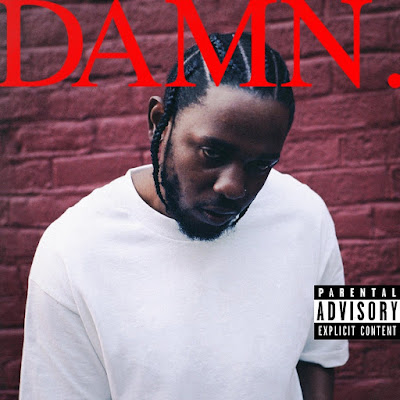In 2015, Kendrick Lamar solidified his status as one of rap's greatest artists with "To Pimp a Butterfly." It was an aggressive, existential album whose timeliness explored the black identity in America while provoking some conversation points. It helped that Lamar's work had purpose and a deeper resonance on even his catchier numbers. In 2017 with nothing to prove after a towering magnum opus, he returns with "DAMN.," an album that strips away his album-long narrative cinematic style in favor of a more raw and personal attack on the culture at large. It's not only a study of race relations in a post-Trump world, but a question as to whether being good in a world full of evil is really worth it.
Even with seemingly blunt track titles, there's a ferocity underneath Lamar's cooling demeanor. Each of the titles is written in capital letters followed by a period, making them sound like 14 sentences or slogans meant to be shouted. There's plenty for Lamar to be upset about in 2017, and he acknowledges them time and again throughout the album. It's a theme that most black artists have come to explore at some point, notably when it comes to Black Lives Matter and the police shootings of innocent young men. "DAMN." uses this particular instance in a bookend fashion. In "BLOOD.," he is seen trying to help a blind woman. In "DUCKWORTH.," he discusses how victimizing black culture impacted him personally. In both cases, the songs end with Lamar being shot - both referring to the instance of kindness.
What Lamar does over the in between is explore his frustration with this dichotomy. He makes consistent shout-outs to how the news, specifically Fox News, reports black culture and skewers them in a negative light. Even as he acknowledges the irony of what Barack Obama and the post-racial society was supposed to achieve, he lingers on the impact that it really had. There's still violence and misunderstanding. It's potentially gotten worse. It creates an anxiety that overwhelms him, even as he goes across how this surface emotional problem ties into his deeper rooted character. He doesn't just speak of brutality, but the contradictions of his life and the identity of being young and occasionally reckless. By "FEAR.," he seems to be atoning for his sins through song, asking the world to forgive him for being arrogant and sometimes selfish.
Gone is the complex production of "To Pimp a Butterfly." In its place is one of Lamar's most immediate albums to date. While he still interweaves themes that play out in repetitive lyrics, the album doesn't focus as much on the samples and production that made his previous album so powerful and important. He's even a bit somber, making songs that are done more in a hushed tone than through boisterous raps. Lamar has evolved to the status of artist, and he's trying to promote rap into a serious art form. It's one where he exists to provoke as well as commentate. He's one of the best because he never settles for an easy club hit. What he wants is to find the lasting appeal, and for him that comes through commenting on the world around him, which is often sudden and unpleasant.
What's thankfully still in tact is Lamar's sense of artistry. Along with some great lyrics, every song is enjoyable both on its own as well as in a thorough narrative. Songs like "HUMBLE." and "GOD." by themselves play like a braggadocios put down of other rappers. In a bigger picture, they explain the character who spends the album questioning his life, wondering why his decision to be nice left him dead at the end of "BLOOD." It's part of why Lamar continues to resonate. He keeps the idea of the album relevant not by making great songs, but using them to tell a story that matters. It's likely that his genius will only continue to grow and in 20 years his music will be scoring documentaries of the various modern movements.
"DAMN." is an album as purposeful as its title would suggest. It may lack the nuance that his previous albums had, but don't mistake that for lack of care. If anything, Lamar cares more. This is an album that warrants deeper dissection to better understand his intents. While many of them seem obvious, there's chances that new clues will continue to rise as the album ages and the listener discovers what's hidden in the production. Even if the cover seems subversively lazy, it has at much depth as the music. Do you judge Kendrick Lamar by his appearance, or do you give him a chance to explain himself? If you pop on the music, there's a good chance that you will think twice about the man in a white tee staring blankly from the album cover. He's not lazy, but in fact brilliant and personal in ways that more music should be.
Overall Rating: 4.5 out of 5

Comments
Post a Comment